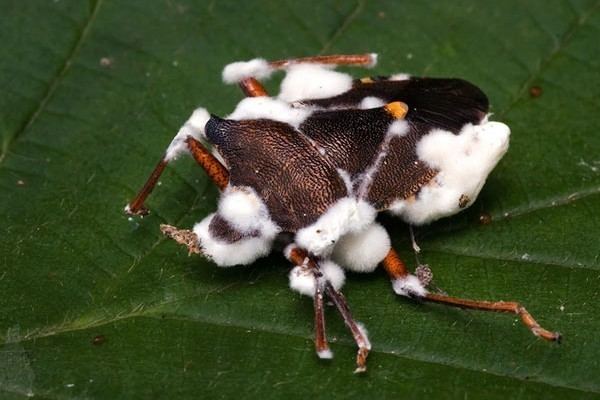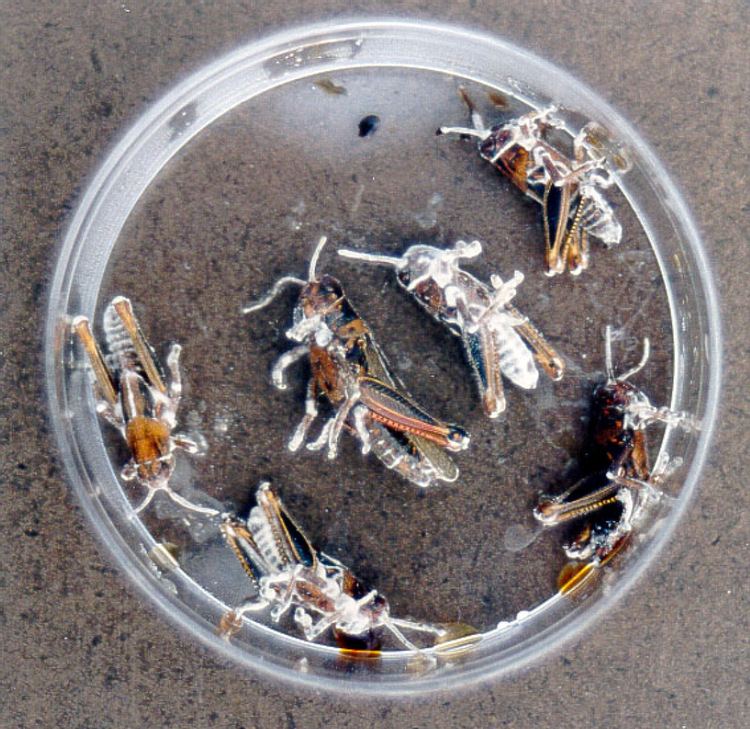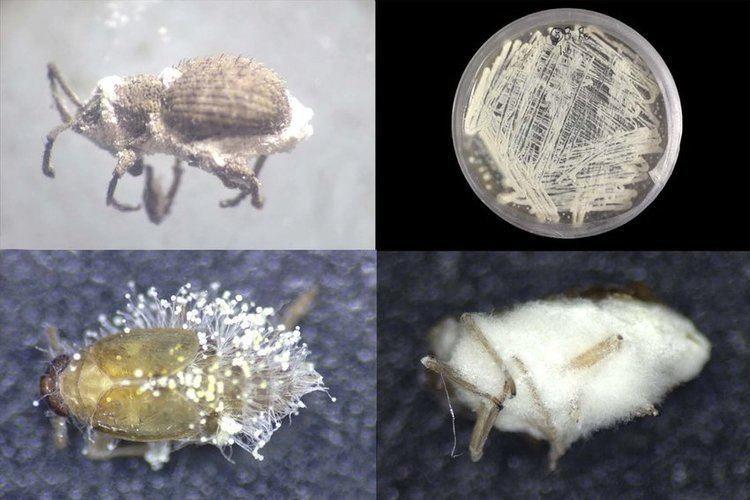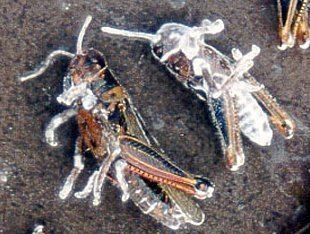Rank Species | Higher classification Beauveria | |
 | ||
Similar Beauveria, Metarhizium anisopliae, Metarhizium, Paecilomyces fumosoroseus, Lecanicillium lecanii | ||
Insect pathogenesis by the fungus beauveria bassiana
Beauveria bassiana is a fungus that grows naturally in soils throughout the world and acts as a parasite on various arthropod species, causing white muscardine disease; it thus belongs to the entomopathogenic fungi. It is being used as a biological insecticide to control a number of pests such as termites, thrips, whiteflies, aphids and different beetles. Its use in the control of bedbugs and malaria-transmitting mosquitos is under investigation.
Contents
- Insect pathogenesis by the fungus beauveria bassiana
- Beauveria bassiana fungus vs bedbugs
- Discovery and name
- Relation to Cordyceps and other fungi
- White muscardine disease
- Morphology of the fungus
- Use in biological control of insects
- Containment leak
- References

Beauveria bassiana fungus vs bedbugs
Discovery and name
The species is named after the Italian entomologist Agostino Bassi, who discovered it in 1815 as the cause of the muscardine disease which then led to carriers transmitting it by airborne means. It was formerly also known as Tritirachium shiotae. The name B. bassiana has long been used to describe a species complex of morphologically similar and closely related isolates. Rehner and Buckley have shown that B. bassiana consists of many distinct lineages that should be recognized as distinct phylogenetic species and the genus Beauveria was redescribed with a proposed type for B. bassiana in 2011. In light of this work and the known existence of cryptic species, it is important to characterise isolates used to develop biological insecticides.
Relation to Cordyceps and other fungi

Beauveria bassiana is the anamorph (asexually reproducing form) of Cordyceps bassiana. The latter teleomorph (the sexually reproducing form) has been collected only in eastern Asia.
White muscardine disease

The insect disease caused by the fungus is a muscardine which has been called white muscardine disease. When the microscopic spores of the fungus come into contact with the body of an insect host, they germinate, penetrate the cuticle, and grow inside, killing the insect within a matter of days. Afterwards, a white mold emerges from the cadaver and produces new spores. A typical isolate of B. bassiana can attack a broad range of insects; various isolates differ in their host range. The factors responsible for host susceptibility are not known.

Beauveria bassiana parasitizing the Colorado potato beetle has been reported to be, in turn, the host of a mycoparasitic fungus Syspastospora parasitica. This organism also attacks related insect-pathogenic species of the Clavicipitaceae.
Morphology of the fungus

In culture, B. bassiana grows as a white mould. On most common cultural media, it produces many dry, powdery conidia in distinctive white spore balls. Each spore ball is composed of a cluster of conidiogenous cells. The conidiogenous cells of B. bassiana are short and ovoid, and terminate in a narrow apical extension called a rachis. The rachis elongates after each conidium is produced, resulting in a long zig-zag extension. The conidia are single-celled, haploid, and hydrophobic.
Use in biological control of insects
Beauveria bassiana can be used as a biological insecticide to control a number of pests such as termites, whiteflies, and many other insects. Its use in the control of malaria-transmitting mosquitos is under investigation. As an insecticide, the spores are sprayed on affected crops as an emulsified suspension or wettable powder or applied to mosquito nets as a mosquito control agent.
As a species, Beauveria bassiana parasitizes a very wide range of arthropod hosts. However, different strains vary in their host ranges, some having rather narrow ranges, like strain Bba 5653 that is very virulent to the larvae of the diamondback moth and kills only few other types of caterpillars. Some strains do have a wide host range and should therefore be considered nonselective biological insecticides. These should not be applied to flowers visited by pollinating insects.
Known targets include:
The fungus rarely infects humans or other animals, so it is generally considered safe as an insecticide. However, at least one case of human infection by B. bassiana has been reported in a person with a suppressed immune system. Additionally, like any powder, the spores may exacerbate breathing difficulties. Wagner and Lewis reported the ability of B. bassiana to grow as an endophyte in corn.
Preliminary research has shown the fungus is 100% effective in eliminating bed bugs exposed to cotton fabric sprayed with fungus spores. It is also effective against bed bug colonies due to B. bassiana carried by infected bugs back to their harborages. All subjects died within 5 days of exposure.
Containment leak
In March 2013, genetically modified Beauveria bassiana was found in a number of research laboratories and greenhouses outside of a designated containment area at Lincoln University in Christchurch, New Zealand. The Ministry for Primary Industries investigated the leak.
